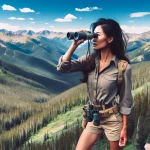Stretching across Grand County, Colorado, the Colorado River Headwaters Byway follows the Colorado River downstream from its headwaters in Rocky Mountain National Park to the towns of Hot Sulphur Springs and Kremmling.
In This Article
Along its 80-mile route, the scenic byway showcases the river’s evolution from a narrow mountain stream to a mighty waterway while providing access to a diversity of recreational activities and conservation efforts focused on protecting the land and wildlife surrounding Colorado’s lifeblood. From rugged natural beauty and roaring whitewater rafting to quaint communities and indigenous history, the Colorado River Headwaters Byway has something to offer every outdoor enthusiast and nature lover.
TL;DR
- The Colorado River Headwaters Byway follows the Colorado River 80 miles from its Rocky Mountain source to the towns of Hot Sulphur Springs and Kremmling.
- The scenic byway provides opportunities for fishing, rafting, hiking, camping, wildlife viewing, and cultural experiences along the upper Colorado River.
- Conservation efforts aim to protect endangered species, restore ecological habitats, and promote sustainable tourism along the byway.
Key Attractions and Activities
The Colorado River Headwaters Byway allows visitors to trace the Colorado River from a narrow stream in the high peaks down into wider valleys surrounded by vast wilderness.
Whitewater Rafting
The upper Colorado River provides exciting Class II-IV rapids for whitewater rafting and kayaking through the Byers Canyon. Outfitters like Mad Adventures lead guided tours down the spectacular shale canyon.
Fishing
The river abounds with wild trout like rainbow, brown, and cutthroat that lure fly fishing enthusiasts. Popular fishing areas include the Pumphouse Recreation Site, Radium Recreation Site, and State Bridge.
Camping
Campgrounds like Eagle’s Nest, State Bridge, and Pumphouse offer tent camping, RV sites, and cabins under the stars with stunning mountain vistas. Dispersed camping is also available.
Hiking and Mountain Biking
Trails like Schoolmarm, Gore Creek, Trail Ridge Road, Gold Belt Tour Scenic and Historic Byway, South Platte River Trail, Pawnee Pioneer Trail Scenic Byway, West Elk Loop Scenic and Historic Byway, and Wheeler Lakes take hikers through pine forests and meadows with panoramic views. Cycling routes like Pebble Creek and Hot Springs vary from gentle to thrilling.
Historic Hot Springs
The scenic byway takes its name from the hot mineral springs that feed resorts in Hot Sulphur Springs like Cottonwood Hot Springs and Hot Sulphur Springs Resort and Spa, where visitors can relax in the healing waters.
Wildlife Viewing
Herds of bighorn sheep, elk and deer, along with black bears, mountain lions, bobcats, and over 200 bird species inhabit the region’s diverse ecosystems like sagebrush valleys, pine woodlands and wetlands.
Cultural Highlights
Beyond the wealth of outdoor recreation, the Colorado River Headwaters Byway also provides a window into the local cultures and heritage that give Grand County its character.
Ranches and Rodeos
Tour working ranches like the Bar Lazy J Guest Ranch and 4UR Ranch to experience the traditions of the American West firsthand. Catch rodeo events to see skilled horsemanship and roping competitions.
Farm-to-Table Dining
Locally sourced ingredients from regional farms and ranches feature heavily on menus at restaurants like Carver Brewing Co., providing a taste of Grand County’s agricultural bounty.
Festivals and Events
Annual events like Winter Carnival, Oktoberfest, rodeos, and concerts celebrate the seasons and keep local traditions alive in Grand County’s charming small towns.
Ute Heritage
Learn about the indigenous Ute people’s deep connection with Colorado’s Western Slope at cultural sites and museums across Grand County, including petroglyphs, pictographs, and artifacts.
Western Hospitality
Grand County’s small-town charm, frontier architecture, and friendly local residents enhance the area’s cultural appeal.
Natural Wonders
Carving through high mountain peaks and rolling valleys, the Colorado River Headwaters Byway reveals the area’s magnificent natural landscapes, unique geology, and diverse ecosystems.
Alpine Peaks
Craggy, snow-dusted peaks soar high above treeline vistas accessible from the scenic byway, including the Gore Range, Rabbit Ears Range, and Never Summer Mountains.
Glaciers and Tundra
Explore remnants of ancient glaciers and fragile alpine tundra ecosystems along high mountain trails and passes like Milner Pass.
River Canyons
Sheer rust-colored canyon walls carved by the Colorado River frame the fast-moving waters below, creating a spectacular sight at Radium Recreation Site and Bair Ranch.
Hot Springs
Geothermal mineral hot springs dot the landscape, flowing into resort pools in Hot Sulphur Springs and creating unique microclimates that sustain lush vegetation and rare plants.
Diverse Habitats
Wetlands, sagebrush valleys, aspen groves, pine forests, and alpine meadows intermix along the byway, providing habitats for diverse wildlife species.
Conservation Efforts
Recognizing the ecological significance of the Colorado River headwaters, public and private entities have implemented various conservation efforts focused on protecting this watershed.
Water Rights
Complex legal processes aim to balance agricultural, municipal, recreational, and environmental water needs along the stressed Colorado River system through agreements like the Colorado River Cooperative Agreement.
Restoration Projects
Local groups like the Upper Colorado River Watershed Group work to restore vital habitats through tree planting, erosion control and invasive species removal along the river.
Sustainable Tourism
Grand County’s “Greenprints” plan promotes sustainable tourism infrastructure like electric vehicle charging stations and recycling facilities to minimize the industry’s footprint.
Environmental Education
Centers like Colorado Headwaters Center educate visitors about regional ecology and conservation issues through interactive exhibits and programs.
Volunteer Opportunities
Volunteers can assist various stewardship programs, helping monitor ecosystems, maintain recreation sites, and rebuild habitats managed by organizations like Rocky Mountain National Park.
Wildlife and Natural Beauty
The Colorado River Headwaters Byway provides easy access to the region’s abundant wildlife and stunning landscapes.
National Forest Scenic Drives
Roads winding through Routt National Forest and Arapaho National Forest offer sightings of elk, moose, and bighorn sheep, plus spectacular mountain vistas.
State Wildlife Areas
Wetland habitats concentrated along the byway in Parshall and Kemp-Breeze attract diverse waterfowl like sandhill cranes, curlews, and blue herons.
Alpine Wildflower Trails
Hiking paths like Corona Pass Trail and Meadows Trail bloom colorful wildflowers in summer against craggy peaks still capped in snow.
River Photography Hot Spots
Scenic pull-offs like Radium Recreation Site and Pumphouse Overlook offer dramatic views of the Colorado River winding through sheer canyons.
Rocky Mountain Mammals
Spot elusive wildlife like black bears, bobcats, coyotes, beavers, and river otters throughout the byway’s forests and wetlands.
History and Heritage
As the life-giving Colorado River shaped this landscape, it also attracted various groups who left their marks on the land’s heritage.
Ute Tribes
Indigenous Ute tribes like the Yampa, Grand, and Uintah frequented the region for thousands of years, following seasonal migration routes and leaving behind artifacts like petroglyphs.
Frontier Outposts
Fur trappers and traders built remote outposts along the Colorado River from the 1820s-1840s that evolved into towns like Hot Sulphur Springs.
Pioneer Settlements
Hardy pioneers ran cattle ranches and farmed the river valley in the late 1800s despite conflicts with Native tribes resisting encroachment.
River Transport
Barges once carried cargo and passengers up the Colorado River to towns like Radium when railroads bypassed the region in the early 1900s.
Remnants of these eras enrich the heritage preserved along the byway through sites like historic homesteads, Ute tribal lands, and frontier museums found in local towns.
Environmental Challenges
As Colorado’s population swells, increased pressures strain the sensitive headwaters environment.
Water Demands
Expanding Front Range cities, plus agriculture and industry, heightened demands on the Colorado River’s limited flows for drinking, irrigation, and hydropower.
Drought
Rising temperatures and below-average snowpacks due to climate change worsen droughts, impacting river habitat health and water availability.
Recreation Impacts
Growing tourism and dispersed camping increase soil erosion, vegetation loss, and water pollution around recreation sites along the stressed river.
Invasive Species
Encroaching non-native plants like tamarisk and fish species such as northern pike disrupt native ecosystems and food chains.
Development Pressures
Additional housing, dams, and mining projects threaten wildlife corridors and degrade river habitats through construction impacts and habitat loss.
Ecological Restoration
In response to these challenges, local agencies and conservation groups actively restore vital habitat along the Colorado River Headwaters Byway through projects like:
Forest Health Initiatives
Thinning and prescribed fire programs reduce fuel loads and regenerate aspen, helping sustain wildlife populations that rely on healthy montane forests.
Wetlands Rehabilitation
Removing invasive species and replanting native vegetation helps revive wetland and riparian areas that support birds, fish, and other species.
Erosion Control
Installing retention ponds, recontouring slopes, and reseeding damaged areas curbs erosion and sedimentation to keep water clear for native fish stocks.
Water Conservation
Municipal and agricultural infrastructure upgrades plus consumer education help reduce water consumption despite population increases.
Wildlife Protection
Seasonal access limits, enforced protection zones, and habitat enhancements maintain refuge areas where vulnerable species can thrive with limited human disturbance.
Community Events and Education
Getting involved with local events and programs enriches visitors’ connections with Grand County’s vibrant community and fragile environment.
Farmers Markets
Weekly farmers markets offer chances to meet local producers and artists while selecting organic produce, artisanal foods, and handmade crafts.
Conservation Volunteer Days
Assist habitat restoration projects through volunteer days organized by parks and nonprofits like Rocky Mountain Conservancy and Headwaters Trails Alliance.
Cultural Festivals
Celebrations of local heritage like Winter Carnival, Ute Tribal Powwows, Ranch Rodeos and Buffalo Barbecues showcase authentic food, music and dance.
Ranger Talks
Join interpretive ranger talks covering topics like wildlife, geology, history, and environmental issues across public lands like Rocky Mountain National Park and Arapaho National Forest.
Youth Education
Hands-on outdoor programs at facilities like Colorado Headwaters Center teach kids about science, conservation, and sustainability on the Western Slope.
FAQ
How long does it take to drive the full byway?
The full 80-mile byway takes around 2 hours to drive non-stop. With stops, plan for a full-day or multi-day road trip adventure.
When is the best time to visit?
The byway offers year-round sights, but peak visitation occurs June-September. Check schedules for specific activities like rafting season, winter hot springs access and summer cultural events.
What towns offer the most amenities along the byway?
Kremmling and Hot Sulphur Springs have the widest selections of lodging, dining, gear shops and supermarkets to stock up for outdoor adventures.
Where are the best spots for photographing the Colorado River?
Top scenic overlooks include the Radium Recreation Site, State Bridge river access, and the Pumphouse overlook south of Kremmling. Sunrise and sunset provide the best golden light.
What is the byway’s elevation range?
The byway descends from around 9,000 feet at the Colorado River headwaters down to 7,700 feet around Kremmling, gaining scenic views of high peaks and river canyons.






